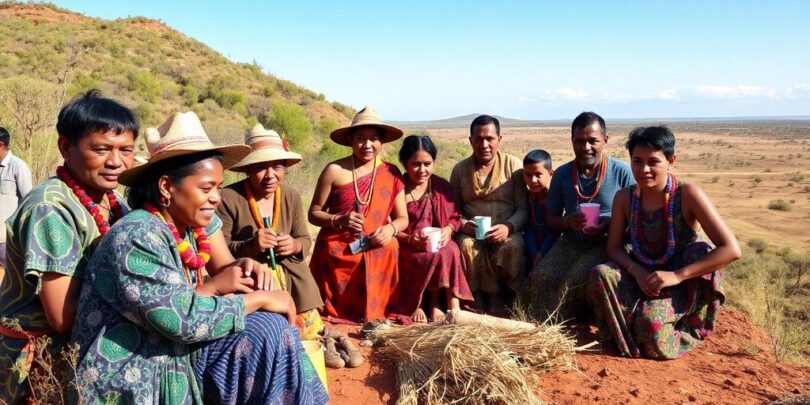In Australia, understanding the social determinants of health for Aboriginal communities is crucial for addressing the significant health disparities they face. These determinants encompass a range of factors, including cultural identity, socio-economic status, and access to healthcare, all of which play a vital role in shaping health outcomes. By examining these elements, we can better appreciate the unique challenges faced by Aboriginal peoples and work towards more effective health solutions.
Key Takeaways
- Cultural identity is a key factor influencing health in Aboriginal communities, linking individuals to their heritage and land.
- Socio-economic factors, such as employment and education, significantly affect health outcomes for Aboriginal peoples.
- Government policies have a direct impact on health equity, often perpetuating existing disparities.
- Mental health in Aboriginal communities is closely tied to social connections and cultural resilience, highlighting the need for trauma-informed care.
- Community-led health initiatives are essential for improving health outcomes and empowering future generations.
Cultural Determinants Of Health In Aboriginal Communities

Culture plays a huge role in the health and wellbeing of Aboriginal communities. It’s not just about what people do, but how they see the world and their place in it. When we talk about health, we need to look beyond just the physical and consider the cultural aspects that give strength and resilience to individuals and communities.
Understanding Cultural Identity
Cultural identity is super important for Aboriginal people’s health. A strong sense of who you are, where you come from, and your connection to culture can really boost your wellbeing. It’s about knowing your history, your traditions, and your place within the community. When cultural identity is strong, people are more likely to feel connected, have a sense of belonging, and be resilient in the face of challenges. This cultural identity acts as a protective factor, helping to buffer against the negative impacts of things like discrimination and disadvantage.
Role Of Language And Connection To Country
Language and connection to Country are absolutely vital. Language is more than just words; it carries stories, knowledge, and cultural values. When language is lost, so much more is lost with it. Connection to Country – the land, the sea, the sky – is also deeply significant. It’s about a spiritual and physical connection that has been there for thousands of years. This connection provides a sense of belonging, identity, and responsibility. Think of it like this:
- Language carries cultural knowledge.
- Country provides spiritual sustenance.
- Both are essential for wellbeing.
Impact Of Community And Family Ties
Community and family ties are the backbone of Aboriginal culture. Strong family networks provide support, care, and a sense of belonging. Community events, ceremonies, and gatherings are all opportunities to connect, share knowledge, and strengthen bonds. These ties are especially important in times of hardship, offering a safety net and a source of resilience. The strength of these community and family ties directly impacts mental and physical health.
It’s about knowing you’re not alone, that you have people who care about you and who will support you through thick and thin. This sense of connection is what helps people to stay strong and resilient, even when things are tough.
Socio-Economic Factors Influencing Health Outcomes
Socio-economic factors play a massive role in the health and wellbeing of Aboriginal communities. It’s not just about having enough money; it’s about the whole system and how it affects people’s opportunities and access to essential services. When we talk about health, we need to look at these underlying issues to really make a difference.
Employment And Income Disparities
Employment rates and income levels are often lower in Aboriginal communities compared to the rest of Australia. This can lead to a whole bunch of problems, like not being able to afford healthy food, decent housing, or even just getting to a doctor. These financial stresses can have a direct impact on both physical and mental health.
Access To Education And Resources
Education is key, but access isn’t always equal. Remote communities might not have the same quality of schools or resources as urban areas. This can affect future job prospects and overall health literacy. It’s a cycle – lack of education can lead to fewer opportunities, which then impacts health outcomes. Addressing health inequity requires a focus on improving educational opportunities and resource availability.
Here’s a quick look at some potential disparities:
- Lower school completion rates
- Limited access to tertiary education
- Fewer vocational training opportunities
Housing Conditions And Health
Where you live matters. Overcrowding, poor sanitation, and lack of basic amenities in housing can all contribute to health problems. Think about it – mould, lack of clean water, and inadequate waste disposal can lead to respiratory illnesses, infections, and other health issues. It’s a basic human right to have safe and healthy housing, and it’s a crucial part of improving overall health outcomes. The primary causes of death coronary heart disease are often exacerbated by poor living conditions.
Addressing socio-economic factors requires a holistic approach. It’s not just about throwing money at the problem; it’s about creating sustainable solutions that empower communities and address the root causes of inequality. This includes things like job creation, skills training, and improving access to education and essential services. It’s a long-term investment in the health and wellbeing of Aboriginal communities.
Political Context And Health Equity
Influence Of Government Policies
Government policies have a huge impact on the health and wellbeing of Aboriginal communities. It’s not just about healthcare; it’s about everything from education to housing. Policies that don’t consider the specific needs and cultural values of Aboriginal people can actually make health outcomes worse. For example, policies around land rights and resource management directly affect access to traditional foods and medicines, which are vital for cultural and physical health.
- Lack of consultation with Aboriginal communities during policy development.
- Inadequate funding for culturally appropriate programmes.
- Policies that perpetuate systemic discrimination.
It’s easy to forget that policies made in Canberra or state capitals have real-world consequences for people living in remote communities. We need to make sure that Aboriginal voices are heard at every stage of the policy process.
Advocacy By Aboriginal Community-Controlled Health Organisations
Aboriginal Community-Controlled Health Organisations (ACCHOs) play a vital role in advocating for the health needs of their communities. They’re not just service providers; they’re also powerful advocates for policy change. ACCHOs understand the unique challenges faced by Aboriginal people and can effectively lobby governments to address these issues. They work to ensure that healthcare services are culturally appropriate and accessible. ACCHOs address the socio-political context of health in many of the activities they provide.
- Lobbying governments for increased funding and resources.
- Raising awareness about health inequities.
- Developing and implementing culturally appropriate health programmes.
Historical Context Of Health Inequities
To really understand the health inequities faced by Aboriginal communities, you have to look at the historical context. Colonial policies and practises have had a lasting impact on the health and wellbeing of Aboriginal people. The dispossession of land, forced assimilation, and systemic discrimination have all contributed to the poor health outcomes we see today. Understanding this history is essential for developing effective strategies to address health inequities.
- The Stolen Generations and their intergenerational trauma.
- The impact of colonisation on traditional lifestyles and cultural practises.
- Ongoing systemic discrimination in healthcare and other sectors.
It’s important to acknowledge that the past continues to shape the present. We can’t just ignore the historical injustices that have contributed to health inequities. We need to address these issues head-on if we want to create a fairer and healthier future for all Australians. The average household income is affected by these inequities.
Social Wellbeing And Mental Health
Social wellbeing and mental health are super important for everyone, but especially for Aboriginal communities. It’s not just about the absence of illness; it’s about feeling good, having strong connections, and being able to cope with life’s challenges. When these things are out of whack, it can have a huge impact on overall health.
Importance Of Social Connections
Social connections are like the glue that holds communities together. Strong relationships with family, friends, and community members provide support, reduce isolation, and promote a sense of belonging. Think about it – when you’re feeling down, who do you turn to? Those connections are vital. For Aboriginal communities, these connections are often deeply rooted in culture and tradition, making them even more significant.
- Sharing stories and traditions
- Participating in community events
- Supporting each other through tough times
Cultural Resilience And Mental Health
Cultural resilience is the ability of a community to maintain its cultural identity and practises in the face of adversity. It’s like a shield, protecting mental health and wellbeing. Aboriginal culture is rich in traditions, knowledge, and practises that have been passed down for generations. Maintaining these connections can be a source of strength and pride, helping people to cope with challenges and build a positive sense of self. The mental health services play a big role in this.
Addressing Trauma And Healing
Unfortunately, many Aboriginal communities have experienced significant trauma due to colonisation, dispossession, and discrimination. This trauma can have long-lasting effects on mental health, leading to issues like depression, anxiety, and substance abuse. Addressing this trauma requires a holistic approach that acknowledges the historical context and promotes healing on individual, family, and community levels. It’s about creating safe spaces for people to share their stories, access culturally appropriate support, and reclaim their sense of self.
Healing is a journey, not a destination. It requires patience, understanding, and a commitment to creating a better future for generations to come. It’s about empowering individuals and communities to take control of their own wellbeing and build a stronger, more resilient future.
Access To Healthcare Services

Barriers To Healthcare Access
Getting proper healthcare can be a real struggle for Aboriginal communities. It’s not just about distance, though that’s a big part of it, especially in remote areas. Think about it: you might have to travel hours to see a doctor, and that’s if you have a car and can afford the petrol. But there’s more to it than that. Sometimes, it’s about feeling like the healthcare system doesn’t really understand you or your culture. This can lead to people putting off check-ups or not seeking help until things get really bad. Plus, there can be a real lack of trust, stemming from past experiences and a feeling that the system isn’t really there to help.
- Distance to services, especially in rural and remote areas.
- Cultural differences and communication barriers.
- Lack of trust in the healthcare system.
Role Of Aboriginal Community-Controlled Health Services
Aboriginal Community-Controlled Health Services (ACCHSs) are super important. They’re run by the community, for the community, and that makes a huge difference. They get what’s going on, they understand the cultural stuff, and they’re often the first point of contact for people who might otherwise fall through the cracks. ACCHSs don’t just treat illnesses; they also focus on things like social and emotional wellbeing, which is crucial. They also advocate for health equity and drive change in the structural determinants of health.
ACCHOs play a vital role in addressing both immediate healthcare needs and the underlying social determinants of health. Their community-led approach fosters trust and ensures culturally appropriate care, leading to better health outcomes for Aboriginal and Torres Strait Islander people.
Culturally Appropriate Care
Culturally appropriate care is all about making sure that healthcare is delivered in a way that respects and understands Aboriginal culture and beliefs. It means healthcare workers taking the time to listen, learn, and adapt their approach to suit each individual. It’s about recognising that culture plays a huge role in health and wellbeing, and that one-size-fits-all approaches just don’t work. This might involve things like having Aboriginal health workers on staff, using interpreters, or incorporating traditional healing practises. Ultimately, it’s about creating a safe and welcoming environment where people feel comfortable seeking help. Culturally appropriate care extends beyond clinical settings, addressing social determinants through community programmes.
- Employing Aboriginal Health Workers.
- Providing interpreter services.
- Incorporating traditional healing practises.
Environmental Determinants Of Health
Impact Of Land And Water Quality
Land and water quality are super important for the health of Aboriginal communities. Think about it – if the land is degraded, it affects everything from the food people can grow to the medicines they can access. Water contamination can lead to all sorts of health problems, too. It’s all connected, and healthy land and water mean healthy people.
Connection To Traditional Lands
For many Aboriginal people, connection to Country isn’t just a nice-to-have; it’s fundamental to their well-being. This connection is about more than just physical space; it’s about cultural identity, spiritual connection, and a sense of belonging. When people are disconnected from their traditional lands, it can have a big impact on their mental and physical health. The sustainable food practises are deeply rooted in the land.
Effects Of Climate Change On Health
Climate change is making things even tougher. We’re seeing more extreme weather events, like floods and droughts, which can disrupt food supplies, damage infrastructure, and displace communities. Rising sea levels are also a major threat to coastal communities. It’s not just about the environment; it’s about people’s health and well-being.
Climate change is not just an environmental issue; it’s a health issue. Aboriginal communities are often on the front lines of climate change, experiencing its impacts firsthand. Addressing climate change is essential for protecting the health and well-being of these communities.
Here are some of the ways climate change is affecting Aboriginal communities:
- Increased heatwaves leading to heatstroke and dehydration.
- Changes in rainfall patterns affecting food security.
- Sea level rise threatening coastal communities.
- Increased frequency and intensity of bushfires impacting air quality and safety.
Community-Led Initiatives For Health Improvement
Successful Programmes And Interventions
Community-led initiatives are really making a difference in Aboriginal health. It’s about empowering communities to take control and develop solutions that work for them. These programmes often focus on cultural connection, education, and access to services, all delivered in a way that’s respectful and relevant.
- Mentoring programmes for young people, connecting them with Elders and positive role models.
- Culturally appropriate health education workshops, addressing specific health concerns in a safe space.
- Community gardens and food programmes, promoting healthy eating and traditional food practises.
It’s not just about treating illness; it’s about creating environments where people can thrive. When communities lead the way, they can address the root causes of health issues and build a stronger, healthier future.
Role Of Local Leadership
Local leadership is absolutely vital. These are the people who understand the community’s needs, strengths, and challenges. They’re the ones who can build trust and ensure that programmes are culturally appropriate and effective. Aboriginal Community Controlled Health Organisations ACCHOs play a huge role here, acting as hubs for community-led action. They provide services that address not only immediate health needs but also the underlying social factors that impact health outcomes. ACCHOs often support clients to tackle issues like housing and income insecurity.
Engagement With Youth And Future Generations
Engaging young people is key to long-term success. They are the future leaders and need to be involved in shaping health initiatives. This means creating opportunities for them to learn about their culture, develop leadership skills, and have a voice in decision-making. Youth engagement can take many forms:
- Youth advisory groups, providing input on programme design and implementation.
- Leadership training programmes, building skills and confidence.
- Creative arts projects, using music, art, and storytelling to promote health and wellbeing.
By investing in young people, we’re investing in a healthier future for Aboriginal communities. It’s about passing on knowledge, building resilience, and empowering the next generation to lead the way. These initiatives are about improving socio-political context for the community.
Wrapping Up
In summary, understanding the social factors that affect health in Aboriginal communities is vital. These factors, like economic status, education, and cultural connections, play a big role in shaping health outcomes. Aboriginal Community Controlled Health Organisations (ACCHOs) are doing important work in this area, providing services that go beyond just treating illness. They focus on the whole person, including cultural and social aspects of health. However, there’s still a long way to go. We need to keep pushing for better policies and support that truly reflect the needs of Aboriginal people. Only then can we hope to close the health gap and improve wellbeing for these communities.
Frequently Asked Questions
What are cultural determinants of health for Aboriginal communities?
Cultural determinants of health refer to the ways that culture, identity, and connection to land influence the health of Aboriginal people. This includes their traditions, languages, and community ties.
How do socio-economic factors affect health outcomes in Aboriginal communities?
Socio-economic factors like job opportunities, education access, and housing conditions can greatly impact health. If people have low income or poor housing, it can lead to worse health outcomes.
What role do government policies play in the health of Aboriginal people?
Government policies can either help or hurt Aboriginal health. Supportive policies can improve health services, while harmful policies can lead to more inequality and health issues.
Why is mental health important in Aboriginal communities?
Mental health is key for overall well-being. Strong social connections and cultural resilience can help Aboriginal people cope with challenges and heal from trauma.
What barriers exist for Aboriginal people in accessing healthcare?
Barriers include distance to health services, lack of culturally appropriate care, and financial difficulties. These can make it hard for Aboriginal people to get the help they need.
How can community-led initiatives improve health in Aboriginal communities?
Community-led initiatives can be very effective because they are designed by local people who understand their own needs. Successful programmes often involve local leaders and engage youth for the future.








